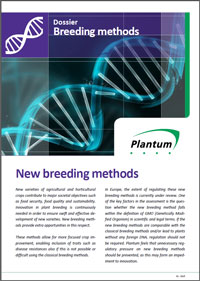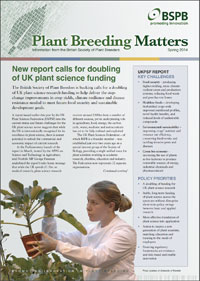|
|
| Print & web publications: books, scientific magazines, etc. |
| Websites |
|
GMO Safety / bioSicherheit
Biological safety research in Germany / Biologische Sicherheitsforschung in Deutschland
New marker genes / Neue Markergene
Marker genes: removal after use / Markergene: Nach Gebrauch entfernen
Wheat CAP
The goal of this project is to increase the competitiveness of public wheat breeding programs through the intensive use of modern selection technologies, mainly Marker Assisted Selection (MAS).
|
| Documents |
|
 May 2016 May 2016
The new VIB Fact Series issue, From Plant to Crop: The Past, Present and Future of Plant Breeding, outlines how the crops we know today were developed via diverse plant breeding techniques. Special attention is given to the New Breeding Technologies (NBT).
Whenever plant biotechnology pops up in conversation, it is usually as part of a debate on GM crops. Nevertheless, selective genetic modification of crops with the use of GM technology is only one of the many possibilities we have to make plants respond better to our needs. This VIB Fact series issue outlines how the crops we know today have evolved from nature, with particular emphasis on the role humans have played.
Since agriculture began around 10,000 years ago, humans have adapted plants to suit their purposes. We selected plants and crossed them so that they slowly but surely become more adapted to our requirements. And with the rise of new plant breeding technologies, a debate started concerning their need, potential risks and technical aspects of how to create the appropriate legislation. In the wake of the GM debate, certain new breeding techniques—which are often referred to with the abbreviation NBTs (New Breeding Technologies)—are coming under increased scrutiny, especially from a regulatory standpoint. This VIB Fact series issue explains how these techniques work, how they differ from generally accepted methods, and what advantages they have over traditional breeding techniques.
Read more from VIB.
Source: Crop Biotech
|
|
 Using Crop Genetic Resources To Help Agriculture Adapt to Climate Change: Economics and Policy Using Crop Genetic Resources To Help Agriculture Adapt to Climate Change: Economics and Policy
Economic Information Bulletin No. (EIB-139) 29 pp, April 2015
|

Factsheet Breeding Methods - New breeding methods
Plantum, 2015
Factsheet Research - Innovation in plant reproductive
Plantum, 2014
New plant breeding techniques - State-of-the-art and prospects for commercial development
Maria Lusser, Claudia Parisi1, Damien Plan, Emilio Rodríguez-Cerezo
European Commission, Joint Research Centre, Institute for Prospective Technological Studies(2011)
Biotechnology and Plant Breeding - Applications and Approaches for Developing Improved Cultivars
Academic Press, 2014
What is plant breeding?
Dr. William .F. Tracy, University of Wisconsin-Madison

Plant Breeding Matters
Information from the British Society of Plant Breeders
- Spring 2015
- Autumn 2014
- Spring 2014
- Autumn 2013
- Spring 2013
- Autumn 2012
- Spring 2012
- Winter 2011
- Summer 2011
- Winter 2010
- Spring 2010
DNA ‘chips’ herald new era in plant breeding - Revolutionary new DNA marker tools that function almost like biological computer chips have opened the way to an unprecedented capability to exploit the vast genetic variation of the wheat gene pool
GRDC, May 2014
Marker Assisted Breeding
Food, Nutrition & Science (May 2014)
QTL mapping, association mapping and marker assisted breeding in lettuce
Ivan Šimko (January 2014)
Marker-assisted selection: a non-invasive biotechnology alternative to genetic engineering of plant varieties
Benno Vogel (August 2009)
Molecular Breeding and Marker-Assisted Selection
ISAAA Pocket K #19 (November 06)
PDF: English version / Chinese version
Marker-assisted selection
Pioneer Hi-Bred, a DuPont company (February 2006)
Molecular markers for genetics and breeding: development and use in pepper (Capsicum spp.)
V. Lefebvre, INRA, UR 1052 GAFL Génétique et Amélioration des Fruits et Légumes. Centre de recherche d'Avignon, France. (2005)
Molecular Marker Systems in Plant Breeding and Crop Improvement
Editors: Lörz, Horst, Wenzel, Gerhard (Eds.), 2005
Provides the molecular basics and techniques for novel plant breeding strategies
Using Molecular Markers in Plant Genetic Research
Unlocking genetic potential for increased productivity
Pioneer Hi-Bred, a DuPont company (September 2001)
DNA markers: where do they come from?
Monsanto Company 2009
|
| Scientific magazines |
Molecular Breeding
Published by Springer Netherlands
Molecular Breeding is an international journal focused on applications of plant molecular biology: research most likely leading to practical applications with demonstrable benefits for farmers, the seed and processing industries, the environment and the consumer in both the industrialized and the developing world.
Plant Breeding
Published by Blackwell Synergy
The journal publishes original papers and short communications by internationally recognized scientists, covering all areas of plant breeding, including plant genetics, plant physiology, plant pathology, and plant development. The journal focuses on crop plants and is therefore of interest to seed companies and the plant breeding industry as well as to researchers and teachers in this field. |
| Books |
|
 Marker-Assisted Plant Breeding: Principles and Practices Marker-Assisted Plant Breeding: Principles and Practices
B.D. Singh, A.K. Singh
2015 | ISBN-10: 8132223152 | 556 pages
Marker-assisted plant breeding involves the application of molecular marker techniques and statistical and bioinformatics tools to achieve plant breeding objectives in a cost-effective and time-efficient manner. This book is intended for beginners in the field who have little or no prior exposure to molecular markers and their applications, but who do have a basic knowledge of genetics and plant breeding, and some exposure to molecular biology. An attempt has been made to provide sufficient basic information in an easy-to-follow format, and also to discuss current issues and developments so as to offer comprehensive coverage of the subject matter. The book will also be useful for breeders and research workers, as it offers a broad range of up-to-the-year information, including aspects like the development of different molecular markers and their various applications. In the first chapter, the field of marker-assisted plant breeding is introduced and placed in the proper perspective in relation to plant breeding. The next three chapters describe the various molecular marker systems, while mapping populations and mapping procedures including high-throughput genotyping are discussed in the subsequent five chapters. Four chapters are devoted to various applications of markers, e.g. marker-assisted selection, genomic selection, diversity analysis, finger printing and positional cloning. In closing, the last two chapters provide information on relevant bioinformatics tools and the rapidly evolving field of phenomics.
Agricultural Biomarkers for Array Technology
Jürg E. Frey, Frédérique Pasquer
(Hardback) 2008
ISBN 978-3-033-01770-2
The main objective of the COST Action 853 was to establish and support microarray technology as a new tool for breeding, diagnosis, and high throughput screening in the field of agriculture. Overall, the Action was highly succesful and the established knowledge will be an important cornerstone for continuing efforts in the field of microarray diagnostics for many years to come.
This book contains articles from many different authors.
Molecular marker systems in plant breeding & crop improvement
(Biotechnology in agriculture & forestry, Vol. 55)
Horst Lörz and Gerhard Wenzel, Editors
Springer
1st ed. 2005. 2nd printing, 2008, XXII, 478 p. 42 illus., 5 in color., Softcover
ISBN: 978-3-540-74006-3
Dec 2007
 Molecular Marker Systems In Plant Breeding And Crop Improvement Molecular Marker Systems In Plant Breeding And Crop Improvement
(Biotechnology In Agriculture And Forestry) October 2007
Breeding by Design: Exploiting Genetic Maps and Molecular Markers through Marker-Assisted Selection
Chapter Authors: Johan D. Peleman, Anker P. Sørensen, Jeroen Rouppe van der Voort
The Handbook of Plant Genome Mapping
Published Online: 28 Apr 2005
Editor(s): Prof. Dr. Khalid Meksem, Prof. Dr. Günter Kahl
Print ISBN: 9783527311163 Online ISBN: 9783527603510
Copyright © 2005 Wiley-VCH Verlag GmbH & Co. KGaA
Plant Molecular Breeding
by H. John Newbury, H. J. Newbury
CRC Press
December 2002
ISBN-13: 9780849328138
|
| Articles |
|
Marker-assisted plant breeding: agricultural genetics without GMOs
Kenrick Vezina, Genetic Literacy Project (April 2014)
Linkage Maps of Wheat Stripe Rust Resistance Genes Yr5 and Yr15 for Use in Marker-Assisted Selection
Lesley R. Murphy, Dipak Santra, Kimberlee Kidwell, Guiping Yan, Xianming Chen and Kimberly Garland Campbell
Crop Science 49:1786-1790 (2009)
Development of Sequence Tagged Site and Cleaved Amplified Polymorphic Sequence Markers for Wheat Stripe Rust Resistance Gene Yr5
Xianming Chen, Marcelo A. Soria, Guiping Yan, Jun Sun and Jorge Dubcovsky
Crop Science 43:2058-2064 (2003)
The challenges in Marker Assisted Breeding
Johan D. Peleman and Jeroen Rouppe van der Voort
EUCARPIA Leafy Vegetables Conference 2003
Prospects for using marker-assisted breeding to improve maize production in Africa
Stevens, Robyn
Journal of the Science of Food and Agriculture, Volume 88, Number 5, 15 April 2008 , pp. 745-755
Is marker-assisted selection cost-effective compared to conventional plant breeding methogs? The case of quality protein maize
Kate Dreher, Michael Morris, Mireille Khairallah, Jean-Marcel Ribaut, Shivaji Pandey, Ganesan Srinivasan
International Maize and Wheat Improvement Center (CIMMYT)
Paper presented at the Fourth Annual Conference of the International Consortium on Agricultural
Biotechnology Research (ICABR), "The Economics of Agricultural Biotechnology," held in Ravello, Italy,
from 24-28 August, 2000
|
|

|

|